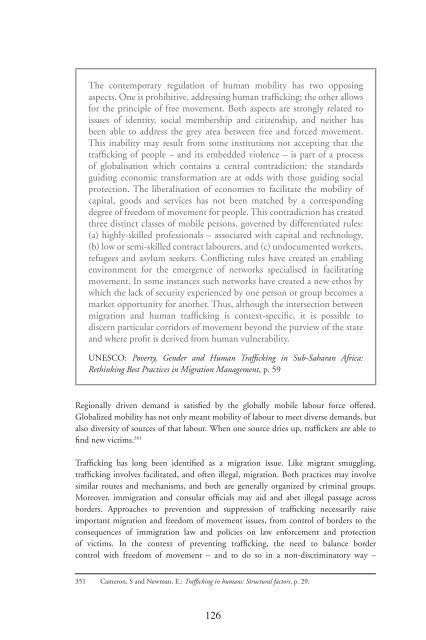Trafficking in human beings: human rights and ... - unesdoc - Unesco
Trafficking in human beings: human rights and ... - unesdoc - Unesco
Trafficking in human beings: human rights and ... - unesdoc - Unesco
Create successful ePaper yourself
Turn your PDF publications into a flip-book with our unique Google optimized e-Paper software.
The contemporary regulation of <strong>human</strong> mobility has two oppos<strong>in</strong>g<br />
aspects. One is prohibitive, address<strong>in</strong>g <strong>human</strong> traffi ck<strong>in</strong>g; the other allows<br />
for the pr<strong>in</strong>ciple of free movement. Both aspects are strongly related to<br />
issues of identity, social membership <strong>and</strong> citizenship, <strong>and</strong> neither has<br />
been able to address the grey area between free <strong>and</strong> forced movement.<br />
This <strong>in</strong>ability may result from some <strong>in</strong>stitutions not accept<strong>in</strong>g that the<br />
traffi ck<strong>in</strong>g of people – <strong>and</strong> its embedded violence – is part of a process<br />
of globalisation which conta<strong>in</strong>s a central contradiction: the st<strong>and</strong>ards<br />
guid<strong>in</strong>g economic transformation are at odds with those guid<strong>in</strong>g social<br />
protection. The liberalisation of economies to facilitate the mobility of<br />
capital, goods <strong>and</strong> services has not been matched by a correspond<strong>in</strong>g<br />
degree of freedom of movement for people. This contradiction has created<br />
three dist<strong>in</strong>ct classes of mobile persons, governed by differentiated rules:<br />
(a) highly-skilled professionals – associated with capital <strong>and</strong> technology,<br />
(b) low or semi-skilled contract labourers, <strong>and</strong> (c) undocumented workers,<br />
refugees <strong>and</strong> asylum seekers. Confl ict<strong>in</strong>g rules have created an enabl<strong>in</strong>g<br />
environment for the emergence of networks specialised <strong>in</strong> facilitat<strong>in</strong>g<br />
movement. In some <strong>in</strong>stances such networks have created a new ethos by<br />
which the lack of security experienced by one person or group becomes a<br />
market opportunity for another. Thus, although the <strong>in</strong>tersection between<br />
migration <strong>and</strong> <strong>human</strong> traffi ck<strong>in</strong>g is context-specifi c, it is possible to<br />
discern particular corridors of movement beyond the purview of the state<br />
<strong>and</strong> where profi t is derived from <strong>human</strong> vulnerability.<br />
UNESCO: Poverty, Gender <strong>and</strong> Human Traffi ck<strong>in</strong>g <strong>in</strong> Sub-Saharan Africa:<br />
Reth<strong>in</strong>k<strong>in</strong>g Best Practices <strong>in</strong> Migration Management, p. 59<br />
Regionally driven dem<strong>and</strong> is satisfi ed by the globally mobile labour force offered.<br />
Globalized mobility has not only meant mobility of labour to meet diverse dem<strong>and</strong>s, but<br />
also diversity of sources of that labour. When one source dries up, traffi ckers are able to<br />
fi nd new victims. 351<br />
Traffi ck<strong>in</strong>g has long been identifi ed as a migration issue. Like migrant smuggl<strong>in</strong>g,<br />
traffi ck<strong>in</strong>g <strong>in</strong>volves facilitated, <strong>and</strong> often illegal, migration. Both practices may <strong>in</strong>volve<br />
similar routes <strong>and</strong> mechanisms, <strong>and</strong> both are generally organized by crim<strong>in</strong>al groups.<br />
Moreover, immigration <strong>and</strong> consular offi cials may aid <strong>and</strong> abet illegal passage across<br />
borders. Approaches to prevention <strong>and</strong> suppression of traffi ck<strong>in</strong>g necessarily raise<br />
important migration <strong>and</strong> freedom of movement issues, from control of borders to the<br />
consequences of immigration law <strong>and</strong> policies on law enforcement <strong>and</strong> protection<br />
of victims. In the context of prevent<strong>in</strong>g traffi ck<strong>in</strong>g, the need to balance border<br />
control with freedom of movement – <strong>and</strong> to do so <strong>in</strong> a non-discrim<strong>in</strong>atory way –<br />
351 Cameron, S <strong>and</strong> Newman, E.: Traffi ck<strong>in</strong>g <strong>in</strong> <strong>human</strong>s: Structural factors, p. 29.<br />
126

















